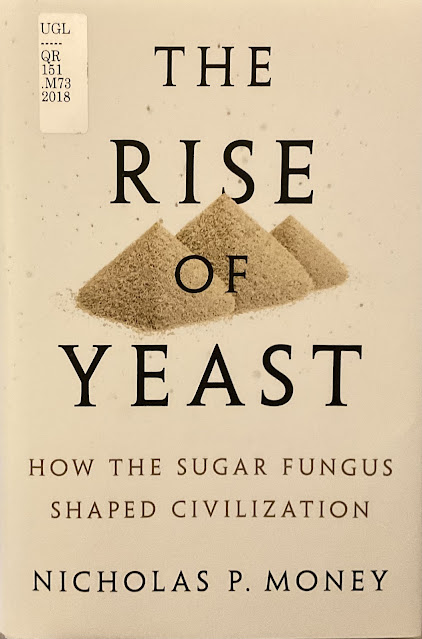The Rise of Yeast: How the Sugar Fungus Shaped Civilization by Nicholas P. Money is a challenging book. In presenting the workings of yeast, discussions are often very technical. The author explains the internal structure of the yeast cells, the details of yeast’s cellular reproduction, and also the chemical formulas for the various alcohol reactions that occur.
Leavened bread, beer, and wine are not the only important products that require the complex organisms classified as yeast; The Rise of Yeast offers information on the expected uses and on the others too, such as the industrial processes that produce ethanol for biofuel and other biotechnology applications. The author includes the history of yeast research, along with the way yeast was discovered to be a living organism. He presents brief sketches of the scientists who worked on discovering yeasts' life cycle and developed its technological uses. The role of yeasts in many natural processes including digestion is included, along with the history of claims that yeast supplements can contribute to health, or contrariwise, the claims that consuming yeast is harmful and should be avoided. One chapter is devoted to diseases caused by yeast — yes, gross!
From the introduction:“Supernatural mediation in the experience of inebriation was imagined throughout the ancient world and alcoholic gods and goddesses flourished, including Dionysus and his Roman manifestation Bacchus, the Aztec god Tezcatzontecati, and the Sumerian goddess Ninkasi…. Wine is the essential beverage of the Bible of course. Benjamin Franklin wrote, ‘Behold the rain which descends from heaven upon our vineyards, there it enters the roots of the vines, to be changed into wine, a constant proof that God loves us, and loves to see us happy.’ For those of agnostic persuasion, we may toast the evolutionary roots of our little fungus.” (p. 5)
From the conclusion:
“Our complex relationship with alcohol, and later with leavened bread, drove agriculture and settlement. From these splendors came civilization, political organization, militarization, and mass starvation. Later fruits of our yeast-driven civilization included science and technology, engineering and medicine, exponential population growth, and the attendant destruction of the biosphere. And in this time of considerable climatic peril, industrial applications of yeast promise major advances in biotechnology and offer some hope — perhaps our only hope — of powering a carbon-neutral economy. The future of humanity depends more on this bug than on any farm animal or crop plant.” (p. 183)
It’s a difficult book, but full of interesting facts and insights. This is my third post this week about yeast, beer, bread, wine, and the associated history and science. Now I’m planning to read something completely different!
Review © 2023 mae sander


7 comments:
Hello,
Thanks for your book review. I could use some help with working with yeast and baking bread. My attempts have not gone well. There must be a secret. I am thankful for the bakeries and breweries. Enjoy your day and the weekend.
It sounds interesting, and alwqys good to learn about these things we regularly use. Enjoy our next book! Valerie
Sounds interesting, my wife might want to read it.
To me, the most fascinating thing about yeast is how long it takes to grow for commercial packaging and use. We had a great shortage during lockdown when everyone was making bread and pineapple beer.
Today I will eat bread and drink wine, so I'll pay my respects to yeast!
That is a pithy title!
I found this fascinating, but because I don't bake bread, I think it was mostly lost on me.
Post a Comment